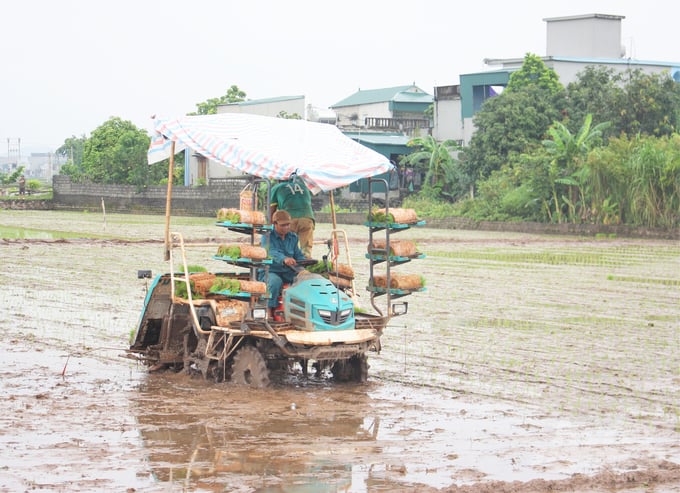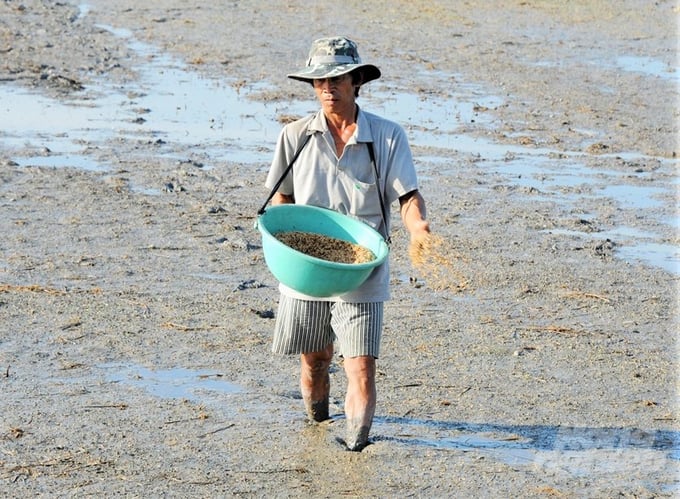June 15, 2025 | 16:13 GMT +7
June 15, 2025 | 16:13 GMT +7
Hotline: 0913.378.918
June 15, 2025 | 16:13 GMT +7
Hotline: 0913.378.918
Adopting mechanization in agricultural production, particularly in rice cultivation, is a way to liberate labor, increase output and respond to crop processes, surmount a labor shortage, reduce production costs and post-harvest loss, and boost farmers' incomes, among other benefits.
In addition, mechanization aids in the acceleration of land accumulation, the formation of large fields, and the promotion of production cooperation and linkages. Using machines is also a method to attract young and experienced labor in rural areas, as well as to reduce the disparity between rural and urban workers.

In the Red River Delta, the percentage of rice-planting area by machine is only about 12%. Photo: Trung Quan.
Red River Delta's strengths include, among others, intensified rice cultivation, specialty rice, a large spot market, a highly intelligent society, and a developed infrastructure. Statistics indicate that the rate of mechanization adoption in rice production in the region is limited to certain phases, such as tilling, irrigation (over 90 percent), plant protection agent spraying (over 80 percent), harvesting (over 80 percent), and transporting (over 75 percent). In contrast, the rate of mechanization at certain phases, such as rice transplantation by transplanter, which reaches only 12%, and drying, which reaches 20%, is low.
According to Mr. Le Quyet Tien, Director of the Research Center for Agricultural and Hydro-Gas Machinery (Vietnam Institute of Agricultural and Post-Harvest Technology - VIAEP), the adoption of synchronized mechanization in rice production in the northern province has been difficult and disjointed between stages. In the transplantation phase, the transplanter rate is minimal. Due to fragmented planting areas and small plot sizes, adoption of modern technologies and machines is problematic.
According to statistics, in the Red River Delta, 98 percent of households have less than 0.5 hectare of land each. Nearly 47% of all fields have a surface area of less than 500 square meters. A little more than 5% of all pastures are larger than 2,000 square meters. The proportion of the field's length (30 - 50m) accounts for slightly more than 31%. In particular, the proportion of fields with lengths less than 30 meters exceeds 8%, while the proportion of fields with widths less than 20 meters exceeds 56%.
In addition, domestic mechanics have not met the demand for agricultural apparatus and equipment in terms of type, quantity, and quality (approximately 33 percent of the demand for mechanical products). Tractors, rice harvesters primarily manufactured by Kubota, Yanmar (Japan), and Korea; sprayers, seeders, and lawn mowers primarily manufactured by Honda (Japan).

The fragmented cultivation area is one of the barriers that makes the rate of mechanized rice transplanting in the Red River Delta still very low. Photo: Hoang Anh.
Mr. Vu Van Tien, Deputy Director of the Department of Economic Cooperation and Rural Development (MARD), stated that mechanisms and policies to support mechanization in the sowing stage have been issued relatively comprehensively, but implementation is still low, particularly in terms of the financial mechanism, due to limited resources. Due to the dearth of collateral, the ability of individuals to obtain loans is hampered by numerous obstacles. The mechanism to support development investment credit for businesses that manufacture agricultural machinery and equipment is not appealing to mechanical investment businesses.
According to the Ha Nam Department of Agriculture and Rural Development, the Provincial People's Committee has issued numerous directives and policies to support the promotion of mechanization in rice production, particularly the sowing stage, such as Decision No. 1340/Q-UBND dated July 2020 of the Provincial People's Committee on the approval of the Project "Development of tray plating service - machine transplanting in Ha Nam province during the period of 2020-2023". By 2023, the province will have provided 50% of the financing for seeds, fertilizers, and plant protection drugs for 16 demonstration models of machine transplant, as well as 50% of the value of 25,000 sowing trays and 50% of automatic tray sowing machines for 10 service teams.
In the future, Ha Nam will continue to support 30% of the value of transplanters with a horsepower rating of at least 4.3 (up to a maximum of 120 million VND). Each organization and individual is limited to one transplanter, while each commune-level unit is limited to five transplanters. Support 30% of the value of the automatic plating tray sowing machine system for transplantation (limit of 30 million VND), support no more than one system per organization or individual, etc.

People's demand for rice transplanting by machines is increasing, but the capacity of the machines is still not guaranteed. Photo: Trung Quan.
This province's rate of planting land by mechanization is only 15%, despite its robust support policy. The number of transplanters in the province is still quite low, with only about 300 individuals. There are 51 large, specialized transplanters, while the remaining transplanters are manual. The average daily capacity of a specialized transplanter is between 2.5 and 3 hectares. Consequently, given the province's average transplanting season of 15 days, each crop can only manage 40-45ha.
In addition, the stage of sowing by machine requires the organization of localities and agricultural service cooperatives to have synchronization from regional planning, serving irrigation, supporting the service of transplanting machines, the cooperative specializing in tray plating - transplanting machines in the province has only 21 operating units, whereas the local population's demand for applying machine-transplanted rice is rising, so it has not yet been established. can be fulfilled adequately.
Regarding land, in Ha Nam it has been converted to an average of 1.2 to 1.5 plots/household (average 500 m2/person), but the majority of it is still on a small scale, fragmented, and unformed in many regions. Concentrated manufacturing of products. This makes mechanization difficult to implement.
The majority of the team operating agricultural machinery and equipment is untrained and lacks fundamental technical knowledge, resulting in numerous problems with the working process, mechanical equipment, and breakdowns, etc.
Over the years, the agricultural sector of the province of Hung Yen has implemented a number of strategies to increase the rate of paddy cultivation by machine. The province presently has 100 transplanters and over 800 sowing tools, according to statistics. In certain regions, humans have developed the practice of sowing seeds by hand (straight sowing).
Mr. Nguyen Xuan Dat, the head of Tan Tien village, Minh Tan commune (Phu Cu district, Hung Yen province), stated that in the past, manual transplanting was the predominant method in the village. The province has a policy that encourages the use of direct sowing and transplanting young seedlings when hybrid rice varieties are placed into production, as this maximizes hybrid advantages and increases productivity.
Numerous households have applied and become "addicted" to direct sowing because they recognize its benefits, which include a reduction in time compared to manual transplanting, minimal labor requirements, and suitability in the context of a labor force shortage.

People in many localities have the practice of direct sowing so they are afraid to change the new transplanting method. Photo: Hoang Anh.
According to Mr. Dat, the direct transplanting method has certain disadvantages, such as requiring soaking techniques and more stringent care procedures, in addition to its advantages. Water regulation must always be ensured, proactively before and after sowing, while in some areas the irrigation system has not yet met irrigation and discharge requirements.
In addition, if sowing is not uniform, it is costly in terms of both seed and exertion to prune and travel distance. If spring weather is extremely frigid, a high proportion of sprouts are damaged. If the crop has just been sown, heavy rain is likely to cause sprouting and loss. Even when the young tree has grown, it is more likely to collapse than rice that has been transplanted.
Additionally, birds and rodents frequently cause more damage to directly sown rice fields than transplanted rice fields. The densely seeded fields are susceptible to pests and diseases, necessitating the use of pricey pesticides. Nevertheless, no villager would consent to return to the manual transplanting method.
Translated by Linh Linh

(VAN) The working delegation from the Ministry of Agriculture and Environment conducted an important trip to the Netherlands to strengthen strategic partnerships and sustainable development in the agricultural sector.

(VAN) The letter ‘A Plea from the Ocean’ not only evokes emotion but also awakens the human conscience to the responsibility of protecting life on Earth.

(VAN) The Department of Agriculture in South Africa has announced the country’s first mass vaccination of poultry to prevent local birds from contracting avian influenza.

(VAN) Establishment of the Mekong Delta Regional Agricultural Linkage Center, aiming for a closed value chain, deep processing, trading platforms, and international market connectivity.

(VAN) Gia Lai province has recently recorded 460 rare species of animals and plants, contributing to forest conservation and biodiversity planning in the region.

(VAN) Ms. Caroline Beresford, New Zealand Ambassador to Vietnam, expressed confidence that agricultural cooperation between Vietnam and New Zealand will develop sustainably, be climate-resilient, and promote gender equality.

(VAN) Vietnam reaffirms its commitment to international cooperation in fostering sustainable and responsible fisheries while ensuring resilient livelihoods for small-scale fishing communities.